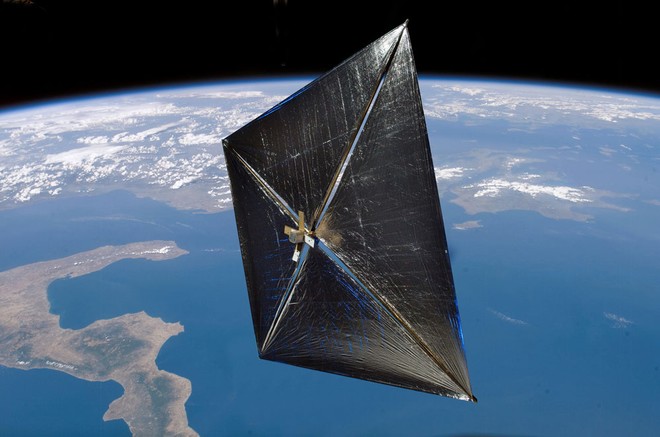The little space sailing vessel that just won't sink.
by Space.com/Sail-World Cruising on 29 Apr 2011

NASA’s solar sailing vessel in space - artist’s impression SW
They were sailing vessels that first explored the oceans of the world without falling off the edge, and it seems sailing vessels could very well lead the way into space. There's a small sailing vessel that has been sailing in low orbiting space since its launch in November 2010 and was meant to sink from orbit and burn up round about now. But the little sailing vessel NanoSail-D, just like a well-found sailing boat, just won't give up.
This means that skywatchers who have yet to spot NASA's prototype solar sail in orbit can take heart -- the little satellite will be zipping around Earth for a few more months yet, space agency officials say.
NASA's NanoSail-D satellite was originally expected to burn up in Earth's atmosphere 70 to 120 days after unfurling its 100-square-foot solar sail, which happened Jan. 20. But the satellite is descending more slowly than anticipated, meaning it should stay aloft at least until July, NASA officials announced this week.
'NanoSail-D has lowered its altitude above the Earth by approximately 28 miles (45 kilometers) from its original altitude of 400 miles (640 km), and continues to descend,' said Dean Alhorn, NanoSail-D principal investigator at NASA's Marshall Space Flight Center, in a statement. [Photos: Spotting Spaceships and Satellites]
The mission team, Alhorn added, now 'predicts NanoSail-D will continue to descend and eventually re-enter Earth's atmosphere and disintegrate six months to one year from sail deployment.'
The change in NanoSail-D's deorbiting plans is in keeping with the little satellite's mission, which has been full of surprises so far.
NASA launched the NanoSail-D solar sail -- the core of which is about the size of a loaf of bread -- on Nov. 19, 2010, from Alaska. The satellite's primary mission was to demonstrate a compact solar sail system. The technology could lead to further development of solar sails for future missions, and could help satellites deorbit cheaply and efficiently, mission managers have said. [Video: Solar Sails Could Clean Up Space Junk]
At launch, NanoSail-D was one of six different scientific payloads aboard a larger satellite called FASTSAT, which is about the size of a washing machine.
On Dec. 6, NASA engineers triggered the ejection of NanoSail-D from FASTSAT. But it apparently didn't work. Then, on Jan. 19, officials announced that the little satellite had spontaneously popped out of its mothership.
Two days later came more good news: NanoSail-D had successfully deployed its solar sail.
'The NanoSail-D mission is NASA's first compact structure to deploy in low-Earth orbit and will be the first solar sail to deorbit,' said Joe Casas, FASTSAT project scientist at Marshall. 'The NanoSail-D mission continues to provide a wealth of data that will be useful in understanding how these type of deorbit devices react to the upper atmosphere.'
The NanoSail-D team has been monitoring the craft's orbital characteristics since sail deployment. They've found that the satellite is orbiting Earth in a flat spin rather than the expected random tumble.
The flat spin attitude causes NanoSail-D to encounter less atmospheric drag, keeping it aloft longer than anticipated, researchers said.
That's good news for skywatchers, who now have a longer window to spot the prototype satellite. As the little spacecraft continues to descend, sunlight glinting off its reflective, tent-size sail will become more and more visible.
Want to try to sight the world's first low orbiting sailing vessel?
The website Heavens-Above (http://heavens-above.com/) provides sighting predictions of NanoSail-D for any place on Earth over the next 10 days.
Another site is Real Time Satellite Tracking (http://www.n2yo.com/?s=25544), which tracks NanoSail-D and a variety of other satellites on an ever-changing world map. It offers 5-day sighting predictions.
Finally, you can use an app (courtesy of SpaceWeather.com) to get the latest satellite predictions on your iPhone.
All good fun!
If you want to link to this article then please use this URL: www.sail-world.com/82925